By Leslie Hunt
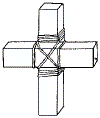
FIG. 1.
SKETCH OF INTERSECTION OF STICKS, SHOWING METHOD OF WRAPPING
Tie on other side with a knot like that shown in Fig. 2.
Prepare two sticks 3/8 by 1/4 by 26 inches and trim them until they are about 1/4 inch wide and quite straight. Plane or scrape the sides very lightly, just enough to make them clean. Take the straighter stick and trim each end to good solid wood, bringing the length to exactly 26 inches. Mark the edges 1/2 inch from each end, and saw a narrow slit parallel to the flat sides down to the mark, or notch the ends as shown in Figure 2. This stick is the spine.
Prepare the other stick in the same manner, only making the total length 22 inches. This stick is for the cross.
From the end of the spine selected for the top, mark 7 and 7 1/4 inches. From each end of the cross, measure 10 7/8 inches and mark all around. These marks designate the place where the sticks will intersect.
Apply a thin coat of glue and place the sticks in position. Square the intersection with one of the end boards of the crate, a book or other suitable object. Tie the sticks in place as shown in Figure 1, using care to keep them at right angles and in the proper position.
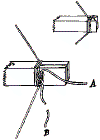
FIG. 2.
END OF STICK, SHOWING METHOD OF FIRST PART OF WRAPPING
After knot is tightened, lay end of string A along stick and wrap with B
about four turns, securing the framing string in the alit as shown in Fig. 3.
The small sketch shows the stick end notched instead of slit. Either method
works very well and allows new sticks to be put in without disturbing the rest
of the kite.
Cut four pieces of string 8 inches long and start wrapping the ends of the sticks as shown in Figure 2. Wrap twice around just behind the mark, tie snugly and leave the ends free. Do not wrap too hard. To break a string while wrapping is almost sure to snap a stick.
Now take the ball of string, tie a knot about 4 inches from the end, and frame the kite by slipping the string into the slits or notches. Start at the top of the spine. The knot keeps the string from pulling through until you are ready to tie it to the other end of the framing string. Draw the string taut but not tight enough to bend the sticks. Tie to the free end at the top, and make final adjustments by squaring and measuring carefully.
Finish the ends of the sticks outside the framing string as shown in Figure 3, and clip off all loose ends.
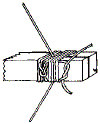
FIG. 3.
FINISHING THE WRAPPING OF THE STICK END. The first half of the knot is tied.
Study Fig. 2 to see how the second half
is tied.
Open a roll of crepe paper on a smooth surface and straighten out the wrinkles caused by the folds, being careful not to stretch the crepe. If there is a right side to the paper, it should be placed down. Hold the paper in place with books or other convenient objects, and place the kite frame, spine side down, on the paper so the ridges of the crepe run the long way of the frame. Bring the top of the spine even with one margin of the paper. Cut the paper larger than the kite so a hem about 3/4 of an inch deep may be turned over the framing string.
The triangular pieces left from the sides will be enough to make the splice at the bottom. Apply paste freely 1/2 inch wide to the bottom margin, and lay the splice on at once patting the paper together with the fingers. Keep the hands clean. There is nothing more annoying than to have bits of trash sticking to the fingers when one is working with string and paper.

FIG. 4.
METHOD OF STRENGTHENING AN IRREGULAR-FIGURE KITE
A sketch of a
dinosaur, or ancient lizard-like animal, is shown in the upper left with sticks
in place. The framing string is shown as a dotted line. The upper right shows
the construction of a blinking eye. The black part of the drawing represents the
pupil of the eye mounted on a short wire X-X' There is a space cut out of the
iris of the eye Z, so the pupil will spin with the wind. The rest of the iris is
made of greased paper. The central sketch shows a trough-shaped piece of paper
glued to the back of the kite surface to give it stiffness. The lower right
sketch is the head of the monster showing the reinforcements just described at
T, and also slivers or shavings glued on at S. This kite will require a tail.
Perhaps a better way of framing can be worked out. A discussion of
reinforcements is given in the Introduction.
Clip the margin carefully on each side of the sticks as far in as the framing string, and crease the paper so it will fold over readily without pulling the string out of place. Clip the paper so none will be pasted to the sticks and paste into place. Go right around the kite, and when all sides are pasted, set away in a warm dry place until dry. Then turn the kite over and finish the paper near the ends of the sticks by folding and pasting.
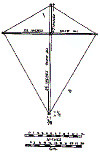
Fig. 5:
FRAME OF TWO-STICK KITE, READY FOR PAPERING
The bridle or bellyband is to be attached to the paper side of the kite. Pull the stretch out of about 8 feet of string, thread it singly on the needle, and run it under the wrapping at the upper end of the spine starting from the top. Pull the string through until about a foot remains.
Run the needle under the wrapping at the lower end of the spine, starting from the top of the wrapping, and pull through so a loop about a yard long will be formed. Cut this loop about 8 inches from the bottom of the kite, and tie the short end into a 1/4 inch rubber band. Pull the string so there is exactly 5 inches between the rubber band and the place where the string touches the kite.
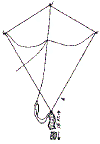
FIG. 6.
FRONT VIEW OF COMPLETED TWO-STICK KITE
In this and other figures, only a portion of the tail is shown. Note the
elastic bridle.
Secure the lower end with two half hitches and let the excess string hang free. Tie a knot in the other string about 8 inches from the end. Tie into the rubber band so the knot will be about two inches above the rubber. Adjust the loop thus formed to exactly 31 inches. Secure the top with two half hitches, leaving enough string hanging free for further adjustments. Bring up the string that is below the kite, and tie it above the knot so the rubber band can stretch about 4 inches before the string checks its extension. Do not pull too hard on the kite in making these adjustments, as a broken stick is sure to result.
The object of this kind of bridle is to prevent sudden gusts of wind from tearing the kite or making it dart violently. It also allows the kite to fly in various velocities of wind without adjustment and at a slightly higher angle than without it.
Attaching the horizontal string requires some patience. You should still have the needle threaded, so proceed as you did for the vertical string, only do not use the elastic arrangement. Keeping the kite flat, bridle side up, draw up the vertical bridle by means of a wire hook so the vertex of the angle formed will be exactly over the spine at a point 5 inches from the top framing string. Remember the rubber will stretch some, so do not draw tighter than necessary to give a feeling of firmness.
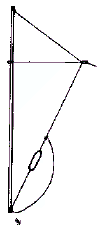
FIG. 7.
SIDE (EDGE) VIEW OF TWO-STICK KITE
Note the bridle and tow string.
Run the horizontal string through the hook, and pull taut. Tie a tow string or leader at this place crisscross through the intersection of the bridle. Secure with a drop of glue. Fix the ends of the horizontal string to the cross stick with two half stitches, leaving enough string at each side for further adjustments.
While the bridle described may be criticized by professional kite-makers, it is satisfactory, easy to adjust, and strong enough for the kites herein described.
Make the tail either of scraps of paper tied to a strong string at intervals of a foot, or use festoon decorations. The tail for the above kite consisted of 15 feet of 1 1/2-inch flat festoon tied on singly. Remember a tail is not for weight as much as it is for air resistance. A string and a stone will not keep a kite as steady as a bushy or fuzzy tail of much less weight.
Attach the tail with string and glue to the lower end of the spine on the stick side of the kite. When dry, the kite is ready for use.
Rating Kites
The dimensions and weight of the kite just described, without tail, were as follows
| Length: 25 inches | |
| Width: 21 1/2 inches | |
| Area: 268 square inches or 1.86 square feet | |
| Weight: .88 ounces |
Rating is found by dividing the number representing the weight by the number representing the square feet. In this case, .88/1.86 =47. The rating is therefore .47 ounce per square foot.
There is no reason why the rating of a kite should be computed unless one cares to take up the kite making pastime as a hobby. In that case, it is well to have a means whereby one kite may be compared with another.
Since the flying power often depends on the surface and weight alone, the weight per square foot gives a ready means of comparison. Other things affecting the flying power of a kite are discussed in Chapter V.
The ratings of nearly all the kites in this book are given. The weight of the tail is not included, as the wind will support the weight of the tail, if the kite and the tail are properly made.